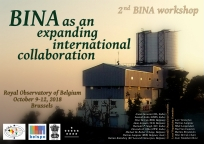Speaker
Mr
Pratik Dabhade
(IUCAA)
Description
In this talk, we will present about Giant Radio Galaxies (GRGs) and highlight the importance of their studies and our efforts to solve major standing problems related to growth and evolution of GRGs and their host active galactic nucleus (AGN). They represent an extreme class of active galaxies which have linear sizes in the range of ~0.7 Mpc to 5 Mpc which places them among the largest single astrophysical objects known to us. Over the past four decades, only ~400 GRGs are known as opposed to thousands of radio galaxies (~10-700 Kpc). It is unsettled if the large sizes of GRGs indicate the high efficiency of radio jets ejected from the central AGN, or they grow to enormous sizes due to their location in sparser cluster environments. In spite of various studies of GRGs, there is still not a single tested unified model which might explain the immense physical scale and other extreme properties of GRGs. Moreover, until now only a small fraction of these GRGs have been studied in sufficient detail in multiple wavebands for achieving a good understanding of their unusual nature. This puts a restriction on carrying out statistical studies of their properties. Firstly, under our project SAGAN (Search & Analysis of GRGs with Associated Nuclei), we have successfully made a complete & uniform sample of all known GRGs from literature, which is first of its kind. Secondly, we are also carrying out large-scale searches for new samples of GRGs using existing radio and optical survey data. Thirdly, we plan to study the hosts of GRGs in multi-wavelengths to understand the nature of accretion, feedback and their excitation types. We have already observed some GRGs with the Giant Metrewave Radio Telescope (GMRT) and we plan to observe their host using the 3.6-m Devasthal Optical Telescope to study near-infrared properties of their host galaxies.
Primary author
Mr
Pratik Dabhade
(IUCAA)
Co-authors
Mr
Biju KG
(W.M.O Arts & Science College, Muttil,Kerala- 673122)
Prof.
Huub Rottgering
(Leiden Observatory)
Dr
Joe Jacob
(Newman College,Kerala)
Prof.
Joydeep Bagchi
(IUCAA)
Dr
Santosh Joshi
(ARIES)

